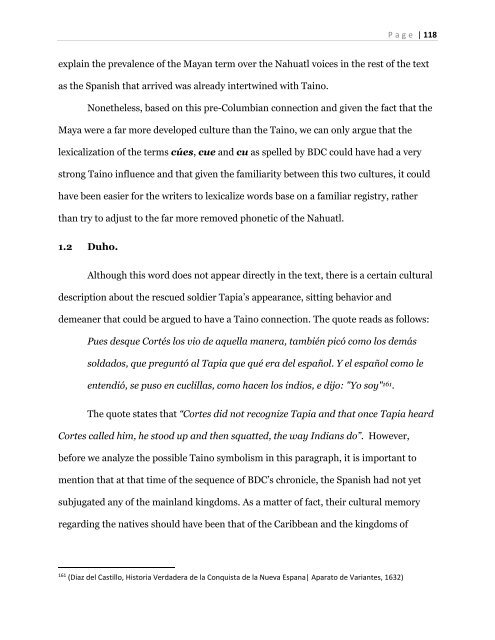Language of the Voiceless: Traces of Taino Language, Food, and Culture in the Americas From 1492 to the Present
by Leonardo Nin
by Leonardo Nin
You also want an ePaper? Increase the reach of your titles
YUMPU automatically turns print PDFs into web optimized ePapers that Google loves.
P a g e | 118<br />
expla<strong>in</strong> <strong>the</strong> prevalence <strong>of</strong> <strong>the</strong> Mayan term over <strong>the</strong> Nahuatl voices <strong>in</strong> <strong>the</strong> rest <strong>of</strong> <strong>the</strong> text<br />
as <strong>the</strong> Spanish that arrived was already <strong>in</strong>tertw<strong>in</strong>ed with <strong>Ta<strong>in</strong>o</strong>.<br />
None<strong>the</strong>less, based on this pre-Columbian connection <strong>and</strong> given <strong>the</strong> fact that <strong>the</strong><br />
Maya were a far more developed culture than <strong>the</strong> <strong>Ta<strong>in</strong>o</strong>, we can only argue that <strong>the</strong><br />
lexicalization <strong>of</strong> <strong>the</strong> terms cúes, cue <strong>and</strong> cu as spelled by BDC could have had a very<br />
strong <strong>Ta<strong>in</strong>o</strong> <strong>in</strong>fluence <strong>and</strong> that given <strong>the</strong> familiarity between this two cultures, it could<br />
have been easier for <strong>the</strong> writers <strong>to</strong> lexicalize words base on a familiar registry, ra<strong>the</strong>r<br />
than try <strong>to</strong> adjust <strong>to</strong> <strong>the</strong> far more removed phonetic <strong>of</strong> <strong>the</strong> Nahuatl.<br />
1.2 Duho.<br />
Although this word does not appear directly <strong>in</strong> <strong>the</strong> text, <strong>the</strong>re is a certa<strong>in</strong> cultural<br />
description about <strong>the</strong> rescued soldier Tapia’s appearance, sitt<strong>in</strong>g behavior <strong>and</strong><br />
demeaner that could be argued <strong>to</strong> have a <strong>Ta<strong>in</strong>o</strong> connection. The quote reads as follows:<br />
Pues desque Cortés los vio de aquella manera, también picó como los demás<br />
soldados, que preguntó al Tapia que qué era del español. Y el español como le<br />
entendió, se puso en cuclillas, como hacen los <strong>in</strong>dios, e dijo: "Yo soy" 161 .<br />
The quote states that “Cortes did not recognize Tapia <strong>and</strong> that once Tapia heard<br />
Cortes called him, he s<strong>to</strong>od up <strong>and</strong> <strong>the</strong>n squatted, <strong>the</strong> way Indians do”. However,<br />
before we analyze <strong>the</strong> possible <strong>Ta<strong>in</strong>o</strong> symbolism <strong>in</strong> this paragraph, it is important <strong>to</strong><br />
mention that at that time <strong>of</strong> <strong>the</strong> sequence <strong>of</strong> BDC’s chronicle, <strong>the</strong> Spanish had not yet<br />
subjugated any <strong>of</strong> <strong>the</strong> ma<strong>in</strong>l<strong>and</strong> k<strong>in</strong>gdoms. As a matter <strong>of</strong> fact, <strong>the</strong>ir cultural memory<br />
regard<strong>in</strong>g <strong>the</strong> natives should have been that <strong>of</strong> <strong>the</strong> Caribbean <strong>and</strong> <strong>the</strong> k<strong>in</strong>gdoms <strong>of</strong><br />
161<br />
(Diaz del Castillo, His<strong>to</strong>ria Verdadera de la Conquista de la Nueva Espana| Apara<strong>to</strong> de Variantes, 1632)


















